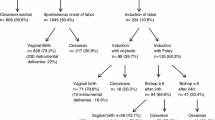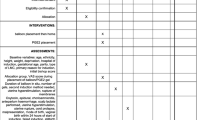Abstract
Objectives
Induction of labour after a previous caesarean section is still controversial. We aim to analyse, in a population of women who have a uterine scar, the maternal, foetal and neonatal complications in relation to the mode of labour and delivery.
Study design
Retrospective analysis of collected data from all the singleton deliveries of patients with a scarred uterus (N = 798), admitted to the hospital between August 2006 and March 2009. Outcomes: maternal and perinatal complications.
Results
Among 798 singleton deliveries, 36.1 % had a spontaneous labour, 12.6 % a prostaglandin-induced labour and 2.9 % an ocytocin-induced labour, and 48.4 % had an elective caesarean section. The chance of delivering vaginally was respectively 84.4 % for those who had a spontaneous labour, 75.2 % for those who were induced using prostaglandin, 82.6 % after induction using ocytocin. There were eight uterine ruptures, four after spontaneous labour (1.4 %), two after prostaglandin induction (2 %) and two at the time of an iterative caesarean section (0.5 %). There were no differences between groups, except the risk of haemorrhage (17.4 % after spontaneously induced labour, 34.8 % after ocytocin, 17.8 % after prostaglandin and 44.6 % after iterative caesarean section; p < 0.005) and the neonatal admissions when analysed by intention to treat only (8.3 % after spontaneously induced labour, 9.1 % after ocytocin, 12 % after prostaglandin and 16.8 % after iterative caesarean section; p < 0.009).
Conclusion
Although no increase in maternal or perinatal outcome was observed in relation to prostaglandin-induced labour after caesarean section, this study is too underpowered to exclude an increased risk.

Similar content being viewed by others
References
McDonagh MS, Osterweil P, Guise JM (2005) The benefits and risks of inducing labour in patients with prior caesarean delivery: a systematic review. BJOG 112(8):1007–1015
Wing DA, Lovett K, Paul RH (1998) Disruption of prior uterine incision following misoprostol for labor induction in women with previous cesarean delivery. Obstet Gynecol 91(5 Pt 2):828–830
Plaut MM, Schwartz ML, Lubarsky SL (1999) Uterine rupture associated with the use of misoprostol in the gravid patient with a previous cesarean section. Am J Obstet Gynecol 180(6 Pt 1):1535–1542
Sanchez-Ramos L, Gaudier FL, Kaunitz AM (2000) Cervical ripening and labor induction after previous cesarean delivery. Clin Obstet Gynecol 43(3):513–523
Yogev Y, Ben-Haroush A, Lahav E, Horowitz E, Hod M, Kaplan B (2004) Induction of labor with prostaglandin E2 in women with previous cesarean section and unfavorable cervix. Eur J Obstet Gynecol Reprod Biol 116(2):173–176
Flamm BL, Anton D, Goings JR, Newman J (1997) Prostaglandin E2 for cervical ripening: a multicenter study of patients with prior cesarean delivery. Am J Perinatol 14(3):157–160
Lydon-Rochelle M, Holt VL, Easterling TR, Martin DP (2001) Risk of uterine rupture during labor among women with a prior cesarean delivery. N Engl J Med 345(1):3–8
SOGC clinical practice guidelines (2005) Guidelines for vaginal birth after previous caesarean birth. Number 155 (Replaces guideline Number 147), February 2005. Int J Gynaecol Obstet 89(3):319–331
Udayasankar VPR, Majoko F (2008) National survey of obstetricians in Wales regarding induction of labour in women with a previous caesarean section. J Obstet Gynaecol 28(1):48–50
Rozenberg P, Goffinet F, Phillippe HJ, Nisand I (1996) Ultrasonographic measurement of lower uterine segment to assess risk of defects of scarred uterus. Lancet 347(8997):281–284
Landon MB, Hauth JC, Leveno KJ, Spong CY, Leindecker S, Varner MW et al (2004) Maternal and perinatal outcomes associated with a trial of labor after prior cesarean delivery. N Engl J Med 351(25):2581–2589
Acknowledgments
We would like to thanks the students who help us to encode data for the study.
Conflict of interest
None.
Author information
Authors and Affiliations
Corresponding author
Rights and permissions
About this article
Cite this article
Cogan, A., Barlow, P., Benali, N. et al. An audit about labour induction, using prostaglandin, in women with a scarred uterus. Arch Gynecol Obstet 286, 1399–1406 (2012). https://doi.org/10.1007/s00404-012-2481-5
Received:
Accepted:
Published:
Issue Date:
DOI: https://doi.org/10.1007/s00404-012-2481-5




